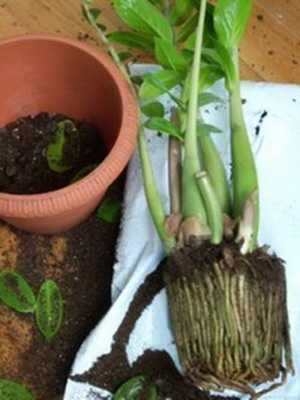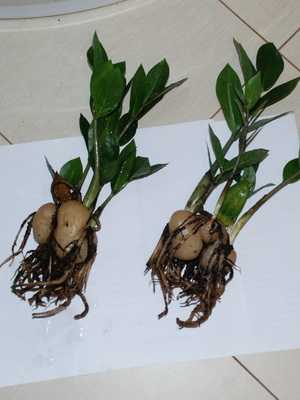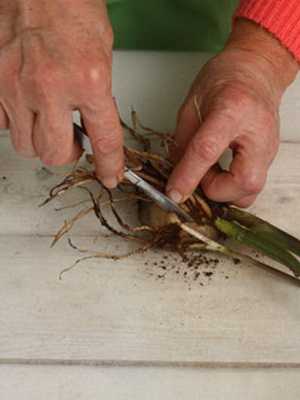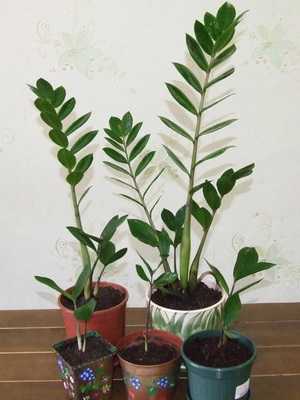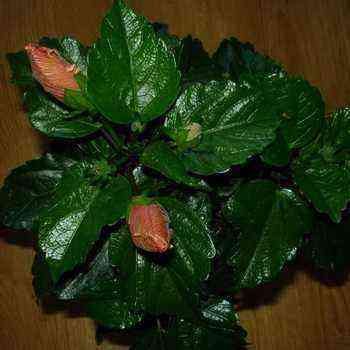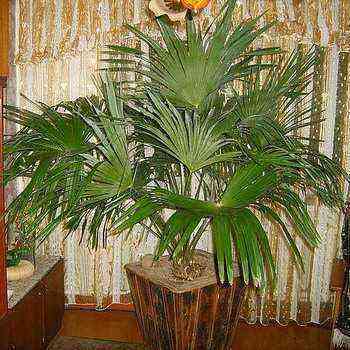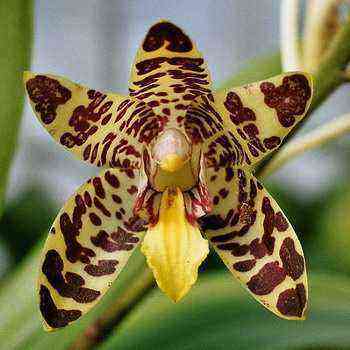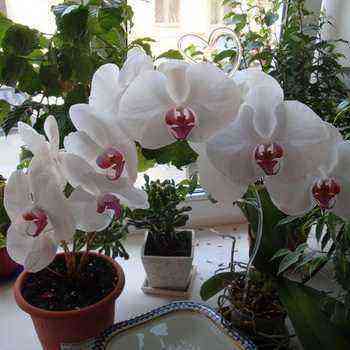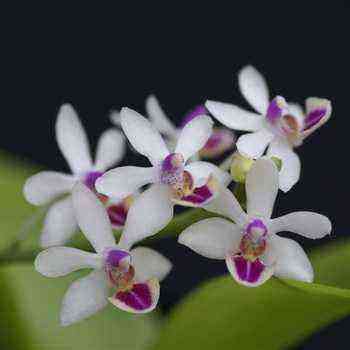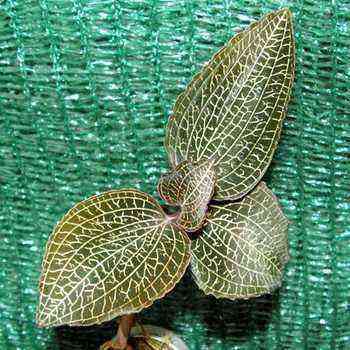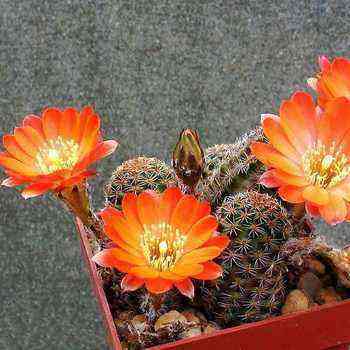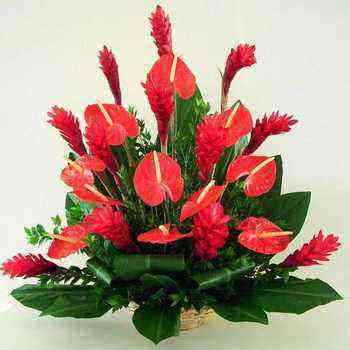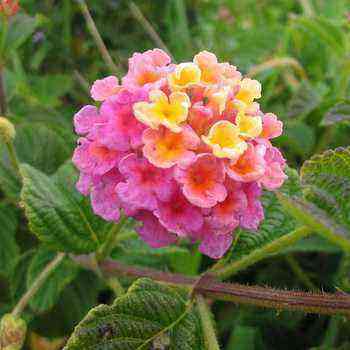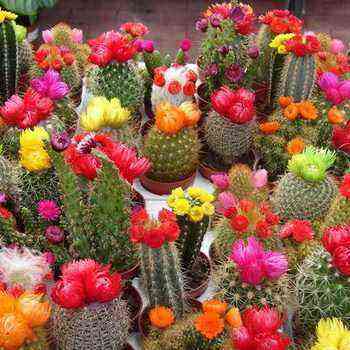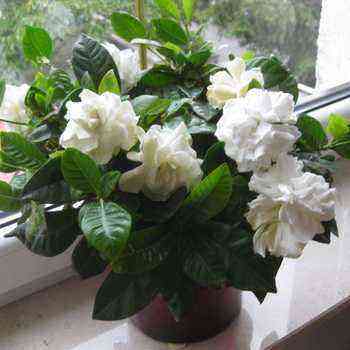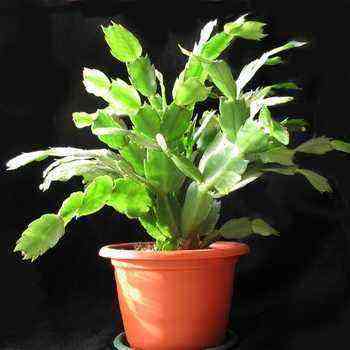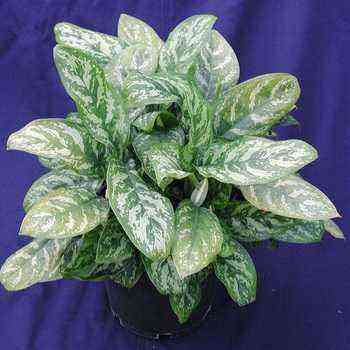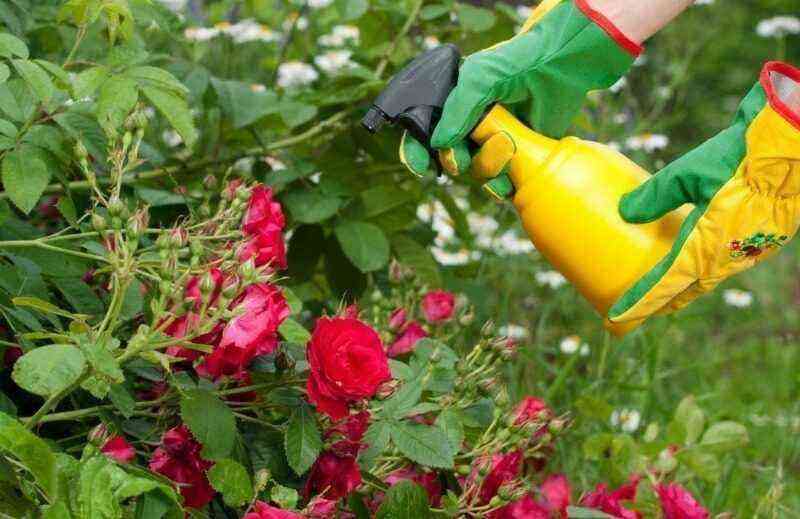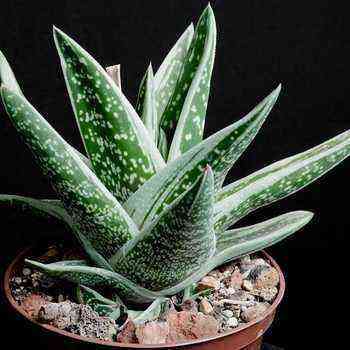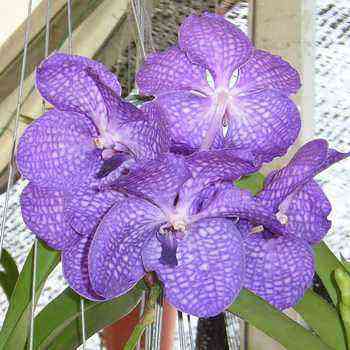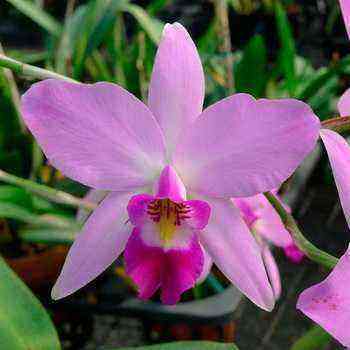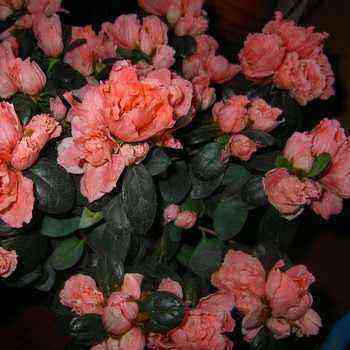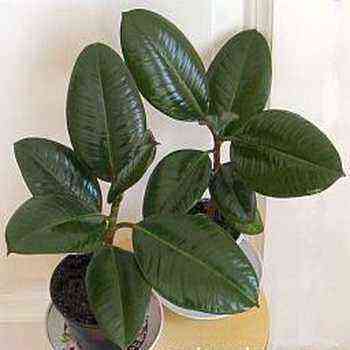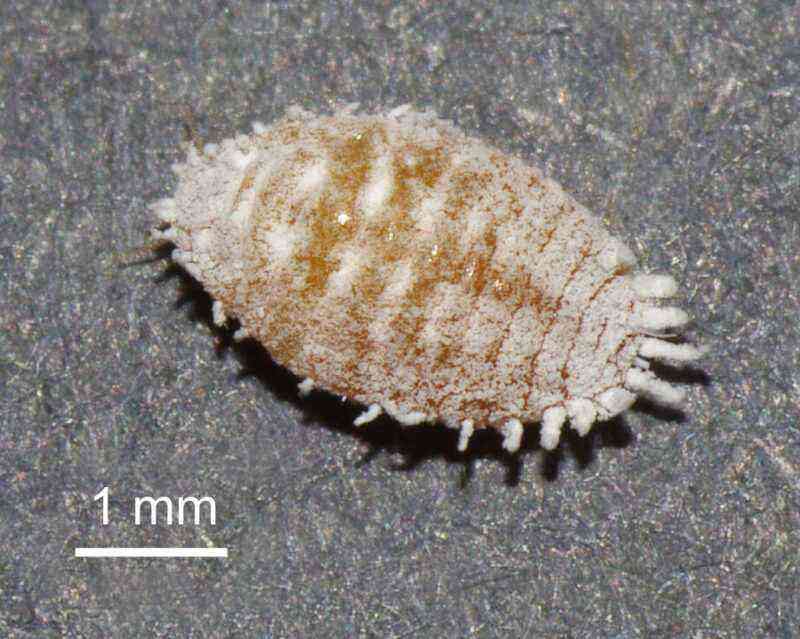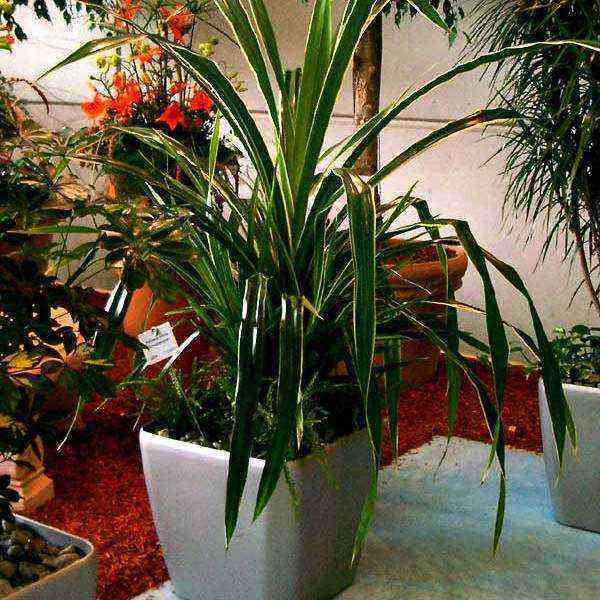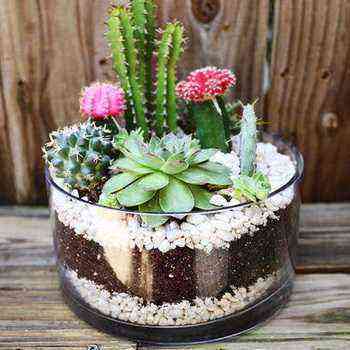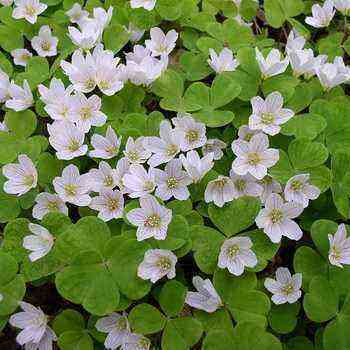 Zamioculcas (Zamioculcas) – herbaceous semi-succulent plant, belongs to the monotypic genus of the Aroid family (Araceae). Homeland – the tropics of East Africa, the island of Madagascar. An evergreen tuberous plant with dark green glossy fleshy leaves. A large tuber in the ground retains water and helps the flower survive during dry periods. The plant is large, it grows up to 1,5 m in the house. The leaves retain their color constantly.
Zamioculcas (Zamioculcas) – herbaceous semi-succulent plant, belongs to the monotypic genus of the Aroid family (Araceae). Homeland – the tropics of East Africa, the island of Madagascar. An evergreen tuberous plant with dark green glossy fleshy leaves. A large tuber in the ground retains water and helps the flower survive during dry periods. The plant is large, it grows up to 1,5 m in the house. The leaves retain their color constantly.
The first scientific description of zamioculcas was made in 1828, but it appeared in European flower shops only at the end of the twentieth century.
Zamioculcas is undemanding in culture, special knowledge is not needed to care for it. A spectacular and unpretentious plant is great for landscaping offices and apartments, it feels great both in hot and in cool rooms. He does not need frequent spraying, just do not overdo it with watering in the cold season. Despite the fact that in nature the zamioculcas flower lives under the sultry African sun, it does not require bright light indoors. Due to its unpretentiousness and unusual appearance, the plant is popular among florists and phytodesigners. It is also known as the dollar tree because many people believe that when properly cared for, the plant brings increased prosperity to its owners.
Varieties and varieties of zamioculcas of the species zamielistny (with photo)
There are several varieties of zamiokulkas, which are not isolated into separate species, but are considered natural variations of one species. They include:
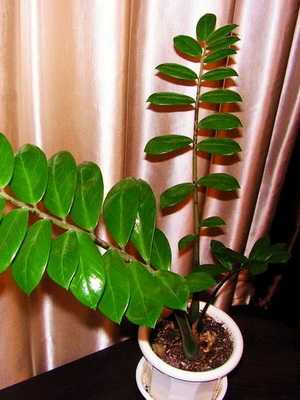
Zamioculcas zamielistny (Z. zamiifolia);
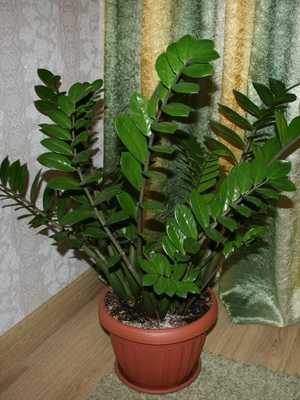
Zamioculcas lanceolate (Z. lanceolata);
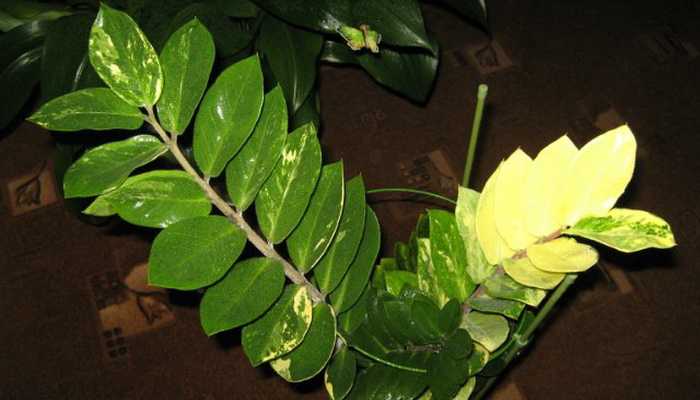
Zamioculcas variegated (Z. variegated).
Leaf blades of lanceolate and variegated elongated variations. These varieties of the only type of zamiokulkas are shown in the photo:
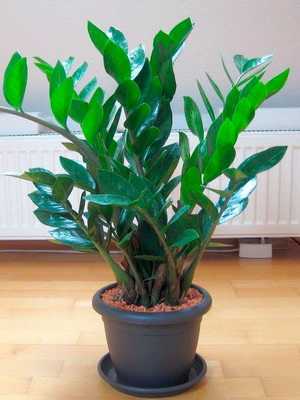
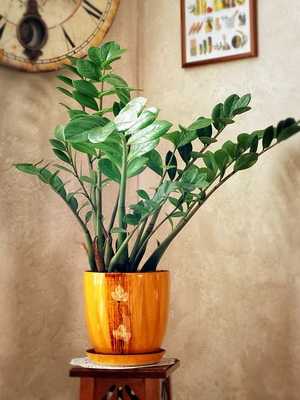
In 2007, the world’s first Zamioculcas variety, Zamicro, was introduced. Unlike the natural species, this variety is no higher than 60 cm and has smaller, graceful leaves.
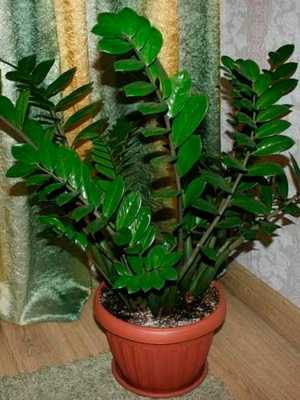

Zamioculcas is most often used as an ornamental indoor plant. This single species of Zamiokulkas got its name for its external resemblance to Zamia, a rare gymnospermous plant.

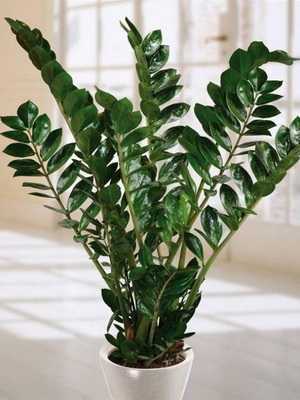
What does exotic zamioculcas look like? Quite unusual. Its trunk is in the soil in the form of a large tuber with moisture reserves, and 4-6 feathery leaves rise above the ground. The leaf petioles in the lower part are highly developed and raised, which is why they are often mistaken for trunks. Cirrus leaves are densely placed on a short horizontal stem, outwardly resembling a rosette. They reach 80-100 cm in length and are covered with dense dark green glossy leaf blades. The climate of its native places has turned zamioculcas into a succulent, where it grows in conditions of hot sun and drought. Thanks to the waxy coating on the leaves, the plant avoids burns and excess moisture evaporation. It grows slowly, new leaves rarely appear.
How zamioculcas blooms in nature and at home (with photo)
It is interesting for novice plant breeders to know how zamiokulkas blooms in nature and at home? The flowering of zamiokulkas in nature is a rare occurrence, since it happens only at a very mature age. In room culture, under appropriate conditions of maintenance, good care, the plant blooms with white and light cream flowers, but already at a fairly old age. The inflorescence is an ear. Flowers of different sexes are located separately on the cob, female – from below, male – from above, and between them there is a zone of sterile flowers. Due to this structure of the inflorescence, its self-pollination is impossible. In nature, the succulent is pollinated by wind or crawling insects that live in the plant’s homeland.
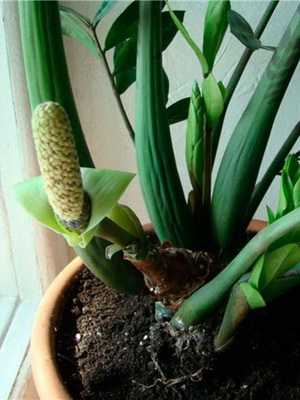
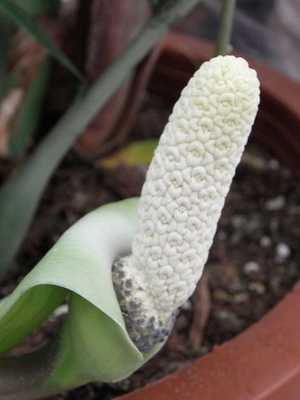
The photo shows how the zamioculcas blooms: inflorescences consisting of an ear and a veil, which appear at the very base of the leaves at a very old age of the plant.
How to care for zamiokulkas in a pot and what to fertilize it
In room culture, the zamioculcas flower is quite unpretentious, and how to care for it is described below. In order to provide zamiokulkas with favorable growing conditions, you should know the features of the environment of its existence.
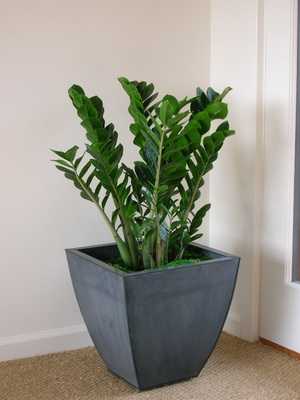
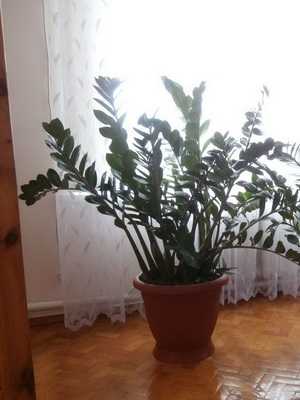
Zamioculcas requires bright diffused light, but it also tolerates partial shade, therefore it grows well on the northern window. With a sufficient amount of light, it grows faster and retains the brightness of its colors. In a dense shade, the growth rate of zamiokulkas will slow down, the leaves will weaken, and there will be fewer of them on the trunk. In summer, the plant can be taken out into an open space with shade from direct sunlight. In order for it to retain its beautiful shape, it must be turned from time to time.

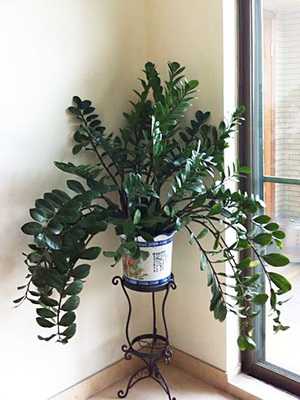
Zamioculcas can withstand a wide range of temperatures, but this plant is thermophilic and does not feel well in cool rooms. It grows best in a warm room with bright, diffused lighting, moderate watering and occasional spraying. The optimum temperature for a dollar tree in summer is 20-26 ° C. It tolerates a temperature rise of up to 30 ° C, but on hot days it is advisable to spray the plant. Zamioculcas is thermophilic, therefore, in winter, the temperature of the content should not fall below 12 ° C, optimally 15-18 ° C.
As for other succulents, air humidity for zamiokulkas does not play a big role. Zamioculcas does not require leaf spraying, it is adapted to dry climates. But to maintain beauty, sometimes the plant needs to “take a warm shower” in order to get rid of the dust settled on the leaves, this procedure should not be repeated more often than once a month. Sometimes you can wipe the leaves of zamiokulkas with a soft damp sponge. Also, spraying will not hurt him if the air is too dry. In winter, it is better to water the plant less often than in summer.
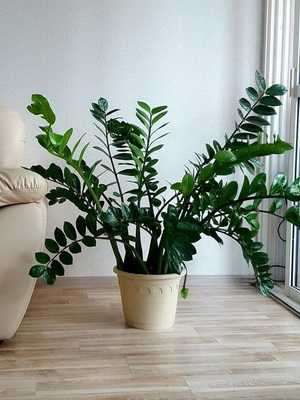

The dollar tree thrives in moderately nutritious, porous soil. Good drainage is a must. The most optimal is the composition of a mixture of sod land, sand and expanded clay, which, if necessary, can be replaced with fine gravel. Of course, a commercially available universal soil is considered the best option, but if you decide to prepare the mixture yourself, then the substrate is prepared from leafy earth, peat, humus and sand (1: 1: 1: 1). If the mixture is homemade, it is recommended to disinfect it. This can be done by sprinkling with boiling water, or igniting in the oven.
Caring for a zamioculcas flower at home is not burdensome, subject to a number of simple rules.
Watering. The main rule for watering zamiokulkas at home is moderation. The plant can be poured, so you need to water it carefully. The fact is that its tuber absorbs moisture, which is necessary for normal development and growth. Thanks to this accumulation, this flower survives drought. Therefore, it is better to underfill than to overfill.
Watering modes for zamiokulkas and cactus are very similar. In summer, the flower is watered not often, but abundantly. In winter, the plant is left dry for several days and only after that moderate watering is carried out.
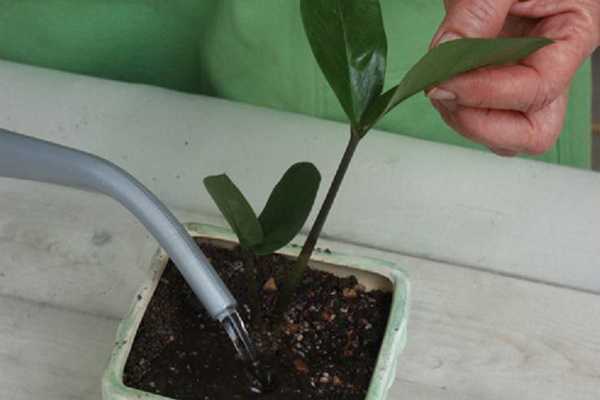
It should be remembered that zamioculcas must be watered only as the soil dries out. Between waterings, the top 2-3 cm layer of the earth should dry out. In summer, watering frequency is 2 times a month, in winter – 1 time per month. It is recommended to defend water for irrigation.
An improper watering regime can cause many plant diseases, as well as cause harmful insects to appear on it. With insufficient watering, the plant loses small leaves, when dry, all the leaves may fall off, when overflowing, the leaves turn yellow and the roots rot. In the latter case, the plant will be difficult to save.
Top dressing. To ensure the normal development of the plant, during the growth period, feeding is carried out with a complete mineral fertilizer, which must be alternated with organic fertilizer. It is better to fertilize zamiokulkas in a complex way than with one type of fertilizer, because the alternation of mineral and organic fertilizers will allow you to grow a large plant sooner.
The feeding period runs from mid-March to mid-September. To do this, use a liquid fertilizer for succulents and cacti. This fertilizer does not contain nitrogen particles and has a slightly lower concentration than other fertilizers. The frequency of feeding is once a month, from April to August – 1 times a month. In winter, it usually does not need feeding.
It should be noted that liquid fertilizer is applied to wet soil no more than once every two weeks. This approach will avoid burns to the plant.
Zamioculcas grows slowly, new leaves appear at long intervals. Older leaves at the bottom fall off naturally. The massive fall of the leaves indicates improper care.
Growing indoor zamiokulkas: how to plant a plant in a new pot
In order for the plant to grow and develop well, you need to know how to care for zamiokulkas in a pot. Therefore, the transplant is preceded by the choice of a pot for the plant. The flower grows best in flowerpots commensurate with the size of the root system (growth accelerates when the roots reach the walls). If the roots of the plant begin to emerge on the surface of the soil, then it needs to be transplanted into a slightly larger flowerpot.
The main stages of transplanting zamiokulkas at home are demonstrated in the video, viewing which will help to avoid mistakes and quickly master the procedure necessary for the plant:
Before planting zamiokulkas, you need to properly prepare the composition of the soil. The soil for zamiokulkas should be loose and porous. Sand or perlite is added to it by at least a quarter of the volume. farmer-online.com Good drainage is essential. At the bottom of the pot, drainage is made from expanded clay, also by a quarter. For better development of a plant in a new pot, its tuber must not be completely lowered into the ground. farmer-online.com
It is better to plant zamiokulkas in a durable plastic flowerpot, since when transplanting it, you can cut it and get the plant out of there without damaging the roots.
Due to the small root system, the flower grows slowly, so young plants should be transplanted no more than once a year, slightly increasing the volume of the pot, and adults – no more than once every 3-5 years. It is better to plant zamiokulkas in the spring. It is necessary to work with rubber gloves, as the plant sap is poisonous. At home, transplanting zamiokulkas in the spring allows the tubers to acclimatize better and quickly build up green mass.
How to properly trim zamioculcas
The question of how to properly cut a zamioculcas can be heard quite often. With normal development, the plant does not need pruning, it forms its own crown. Zamioculcas are pruned when they want to rejuvenate the old leaves that have become woody in the lower part, or simply give a certain shape to the plant. If, due to improper growth, it is necessary to cut off the zamiokulkas for better nutrition of the branches, it is best to do this during the period of active growth – in the spring.
For the least damage to plant tissue, it is recommended to use a small, sharp pruner. Can be cut with a short, sharp knife. The place of trimming must be dried to prevent pathogenic microbes from entering the open vessels of tissues. For the same purpose, you can sprinkle large cuts with crushed coal.
Zamioculcas diseases and methods of their treatment
Below are the most common zamioculcas diseases and how to treat them.
Destruction of the root system. During this disease, the flower practically does not grow. This is due to overflow, which is the greatest danger to the plant. Watering was too frequent or the sump was not supplied with water. This disease leads to the death of the dollar tree. The only way out of the situation is to cut off the cuttings and root them in the newly prepared soil.

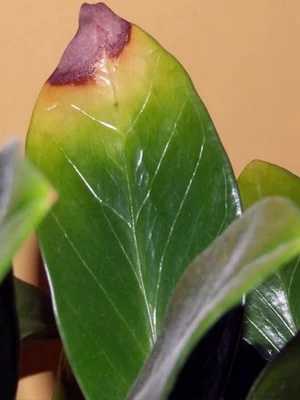
Dark spots on the trunk. Appear due to improper plant care. To eliminate stains, you need to revise the care regimen.
Shrinking of the stem when there is a lack of water. Another cause of this disease may be soil hardening. It is necessary to loosen it and ensure the plant is properly watered.
Often there is a problem when the leaves of zamiokulkas turn yellow, which can be caused by the following reasons:
- Natural aging, due to which only the lower leaves turn yellow and fall off. At the same time, new leaves appear on the top of the plant. This is a normal, natural process that does not depend on care.
- Sudden changes in temperature. In this case, the plant has a massive yellowing of the leaves. It is necessary to check whether the flower is standing in a draft and whether a cold stream of air falls on it.
- The wrong watering regime causes yellowness on young leaves.
- Dry indoor air leads to yellowing and drying of the tips of the leaves. It is necessary to occasionally spray the plant with warm water.
A succulent of unusual beauty rarely suffers from parasites; they are frightened off by a thick peel that protects the zamioculcas. But sometimes it can be affected by such pests: scale insects, spider mites, aphids. If you find insects, you should treat the leaves of the plant with warm soapy water. If this remedy does not work, special preparations are used to eliminate this kind of parasites.
Thus, the answer to the question of how to care for a zamioculcas plant is to follow the simple rules of watering, feeding, transplanting and pruning a dollar tree. As a token of gratitude, it will surely bloom its rare, but very unusual flowering.
Reproduction of zamiokulkas by cuttings in soil and water
At home, reproduction of zamiokulkas is possible in several ways. This plant reproduces vegetatively.
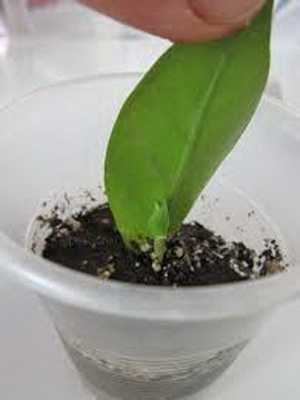

Reproduction of zamiokulkas by leaf cuttings is the most preferred method. For harvesting cuttings, a well-developed, complex, middle-aged leaf on an adult plant is used. In the lower part of the leaf, leaf blades are removed from the rachis. For planting, you can take only a part of a large leaf – the top is 15-20 cm long with 4-5 leaves. Slices must be treated with crushed charcoal or a root growth stimulant – zircon, root. After such treatment, they will be protected from disease.
It is better to dry the stalk a little before planting. When rooting cuttings, it is advisable to use soil heating, as well as to use phytohormones for better root formation. Leaf blades and cuttings are rooted in a mixture of sand and peat (1: 1) in a warm place with diffused lighting, covered with glass or polyethylene to maintain moisture. Under these conditions, the leaves form a rounded tuberous organ on which the bud and roots develop. The pot with the shank is placed in a warm place and sprayed regularly. Rooting can take up to two months. When the roots appear, the stalk of the zamiokulkas is transplanted into a small pot with a loose substrate (for example, soil for cacti and succulents). When planting in ordinary soil, sand, perlite, vermiculite are added for porosity.
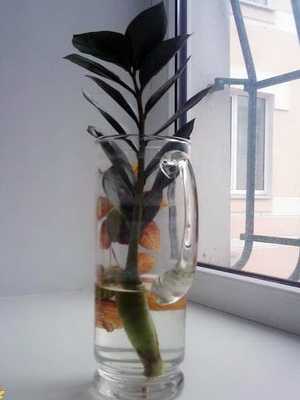
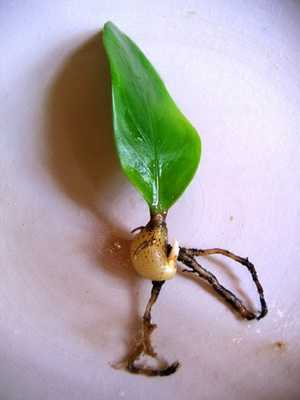
In addition to the above-described method, it is possible to multiply zamiokulkas in water used as a medium for the formation of the root system. A strong, mature stalk is selected and separated from the mother plant. Then the cut site is treated with root-forming stimulants (root, zircon, heteroauxin). The stalk is placed in a container with water with the addition of activated carbon or fungicide, which suppress the decay process, and left on the window. After about 1-1,5 months, after the roots appear, the young plant is planted in prepared soil.
How to breed zamiokulkas: propagation by leaf and tubers at home
Reproduction of zamiokulkas leaf at home is as follows. In an adult plant, the leaf is separated from the central vein (rachis) of a complex leaf, the cut is sprinkled with charcoal, the cut leaf is dried for 1-2 hours and planted at an angle in a glass with soil so that 1/3 of the leaf is in the substrate.
Reproduction of zamioculcas with a tuber is a fairly simple way in which only an adult plant with large tubers can be propagated. The tuber, growing, divides itself, and the daughter tubers are formed quickly enough. At the next transplantation of the mother plant, the tuber is divided so that at least one growth point is preserved in each part. The larger the part taken for reproduction, the faster a developed plant will turn out. After dividing, the resulting parts are dried for several hours, the sections are treated with charcoal and planted in containers filled with a light substrate with a loose structure, without deeply burying the head of the tuber. Regular moderate soil moisture begins 3 days after planting. Dividing a tuber is not the most convenient way of reproduction, since a new bush grows very slowly.
How to breed zamiokulkas in stages by different methods, you can also look at the photo:
